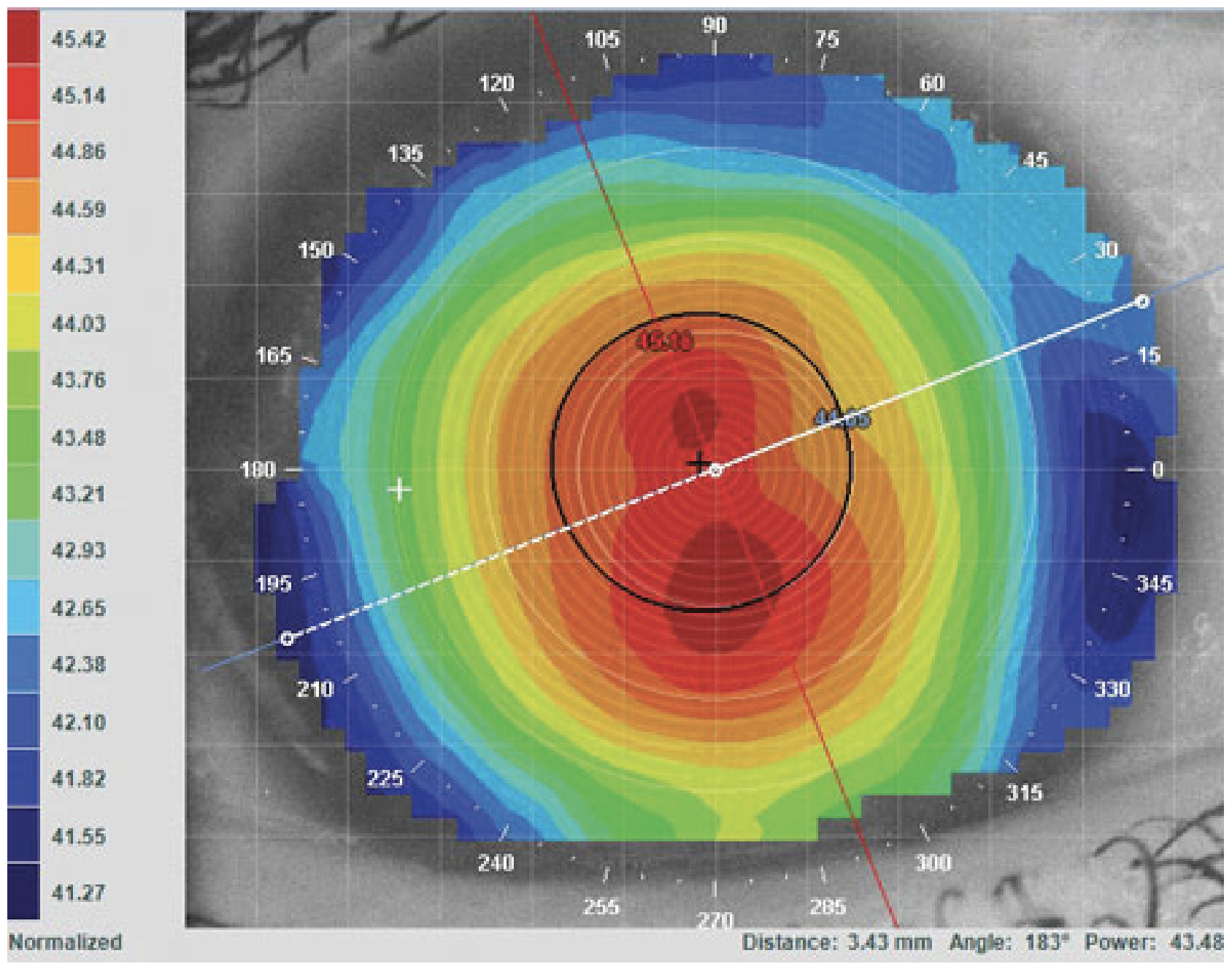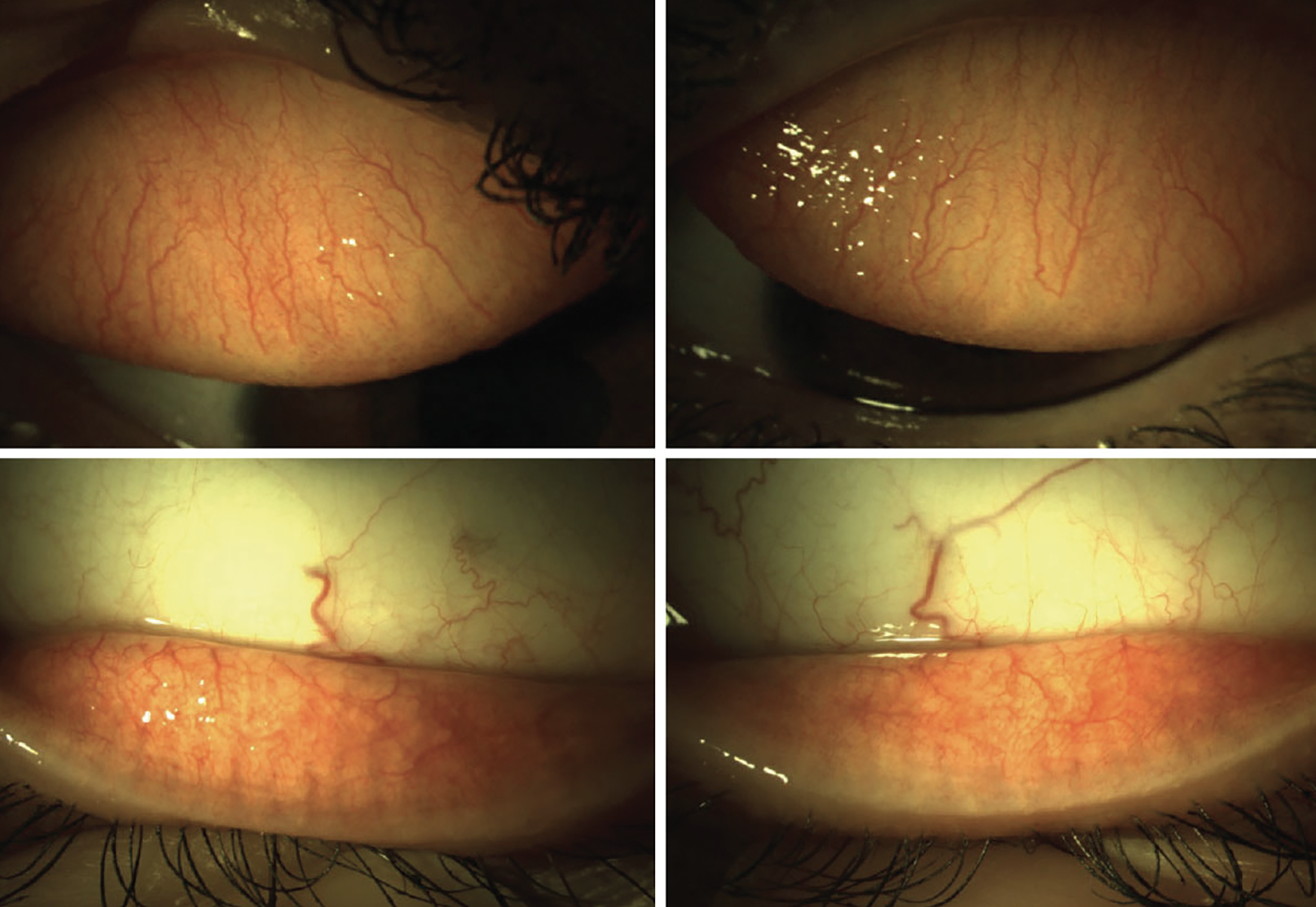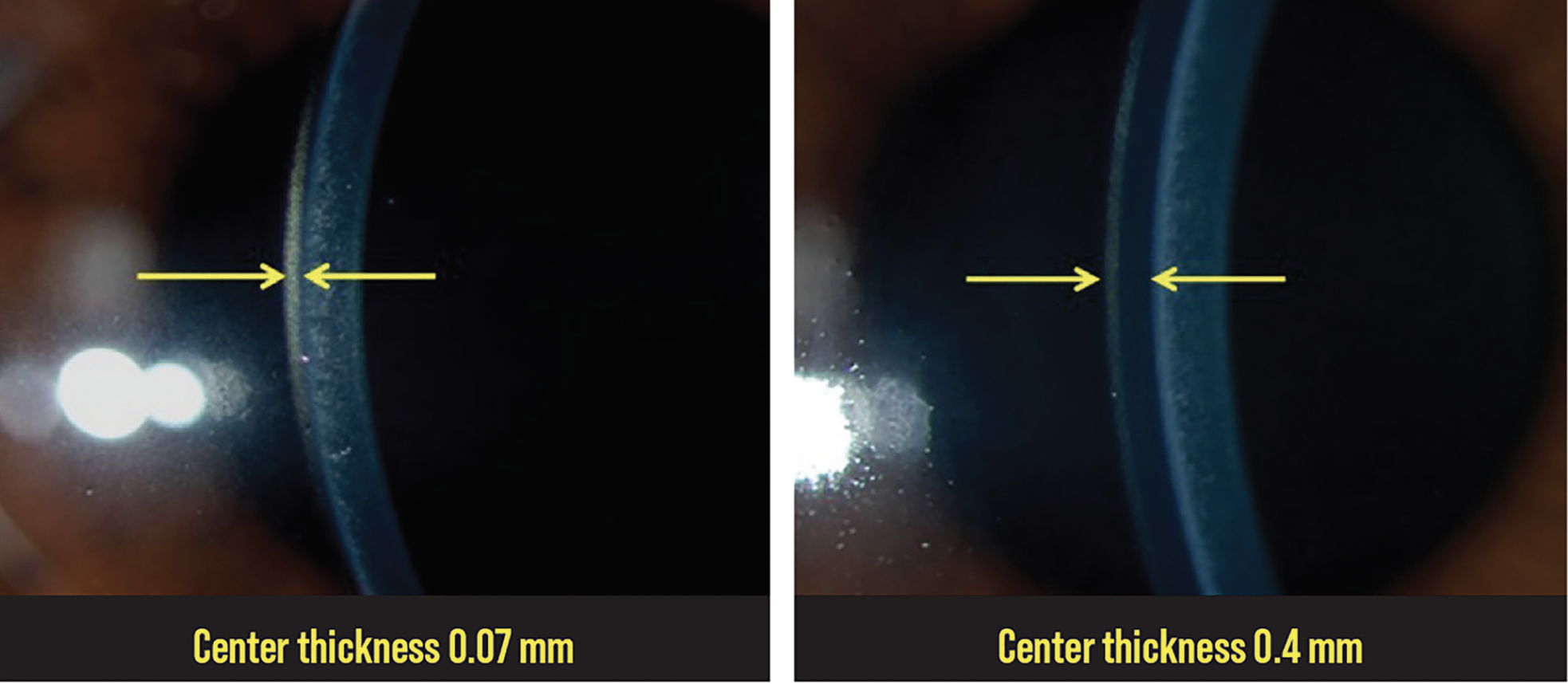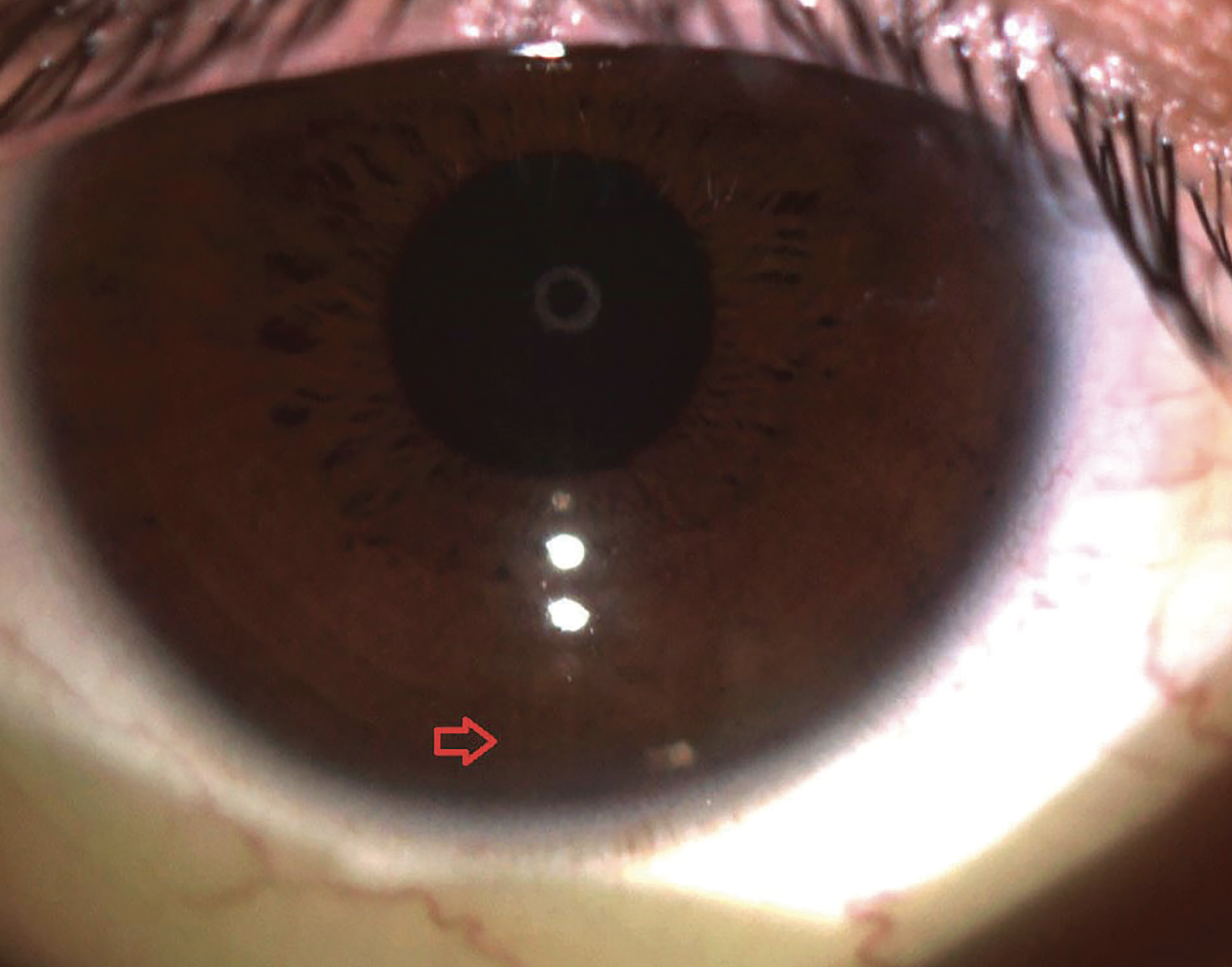Staying abreast of the latest technologies and innovations is paramount for the delivery of comprehensive and effective patient care. It is also critical for the ongoing growth and success of optometry. Soft toric contact lenses have emerged as a valuable tool to address the unique needs of individuals with astigmatism (Figure 1). As optometrists, harnessing the full potential of these lenses can enhance patient outcomes and satisfaction as well as your own clinical practice.
“Modern toric technologies give us the ability to correct vision in a predictable way that we weren’t able to in the past,” notes Mile Brujic, OD, who practices in Bowling Green, OH. “Today, we have a host of stable lens options that ensure we can deliver the best possible visual outcomes to our patients with astigmatism.
“Optimal patient outcomes are always what’s in the best interest of the practice,” he adds. “Toric lenses are another example of a specialized offering that adds value for both patients and optometrists alike.”
Nonetheless, some ODs remain hesitant to integrate these services into clinical practice. “The NHANES study determined that in the US, about one-third (36%) of the population have 1.00D or more astigmatism.1 However, only 21% of all contact lens fits were for soft toric lenses in 2023,” points out Thomas Stokkermans, OD, an associate professor at the Case Western Reserve School of Medicine and director of optometric services at University Hospitals Cleveland Medical Center.2 “This gap identifies an unmet need that we have the tools to meet,” he notes. “And this doesn’t include all those patients with less than 1D of astigmatism that may also benefit from the increased clarity that astigmatic contact lenses can provide.”
Misapprehensions and Misconceptions
There are a variety of reasons why an optometrist might not be taking full advantage of the benefits of soft toric lenses. Below, optometrists discuss some of the concerns surrounding this modality and why they shouldn’t stop ODs from integrating toric lenses into their practices.
“Misapprehensions regarding soft toric contact lenses include poor lens performance (unstable rotation), discomfort with lens wear and lack of parameter availability,” says Jennifer Harthan, OD, a professor at the Illinois College of Optometry and chief of the Cornea Center for Clinical Excellence at the Illinois Eye Institute. “Some practitioners elect to fit astigmatic patients with the spherical equivalent power to try to avoid these misapprehensions,” she explains. “However, this can lead to more vision complaints such as blur, glare, halos and ghosting of images, particularly for those with higher levels of astigmatism.”
 |
|
Fig. 1. Soft toric lenses can correct various levels of astigmatism. Patients with central corneal astigmatism are often better candidates than those with limbal astigmatism due to the geometry of the lens. Photo: David Kading, OD, and Charissa Young, OD. Click image to enlarge. |
Another common concern is increased chair time. However, Dr. Stokkermans has not found this to be the case. Research suggests that the average chair time is actually similar.3 In fact, he notes, not offering astigmatic correction can compromise a patient’s vision and may increase chair time while trying to find a lens that meets the patient’s visual expectations.
The cost associated with toric lenses is also a reason for hesitation among ODs. A recent study showed that toric lenses are about 30% more expensive than their spherical counterparts, notes Dr. Stokkermans; however, the same study found that patients were willing to pay up to 50% more for the improved vision and similar comfort of toric lenses.4 Although cost is an important consideration, it shouldn’t be used as a reason not to explore this option with your patients.
As mentioned above, the comfort of toric lenses has long been a point of contention. While there are different reports on whether toric soft contact lenses cause more discomfort, the general consensus today is that comfort is similar.4
 |
|
Fig. 2. Everting the upper and lower eyelids can reveal signs of ocular surface issues (such as papillae, shown here) that may either be a result of contact lens wear or have implications for its success. Photo: Jennifer S. Harthan, OD, and Michelle K. Man, OD. Click image to enlarge. |
“With the availability of so many new materials and designs, the first step, if comfort appears to be an issue, is to change the design, replacement regimen and/or lens material,” says Dr. Stokkermans. “I may check for papillae (Figure 2) if I have a patient with an atopic profile (e.g., history of eczema, asthma or perennial allergies) or someone with a history of contact lens intolerance to avoid inducing GPC.” He advises, “It is always essential to carefully check the eyelids for anterior and posterior blepharitis and check the tear film.” In certain cases, Dr. Stokkermans says he may perform additional dry eye testing.
There may also be apprehension surrounding the fitting of patients who require a higher contact lens power or who have parameters outside commercially available lenses, notes Dr. Harthan. “There are several custom soft toric contact lens designs available that can be customized for these patients,” she points out (Figure 3). Consultation, she adds, can be a great resource.
 |
|
Fig. 3. Irregular astigmatism patients may benefit from custom-fit soft toric contact lenses due to the increased central thickness of the lens. Photo: Matthew Lampa, OD. Click image to enlarge. |
Understanding the Value
Soft toric lenses offer improved visual acuity, particularly under low light conditions, as well as improvements in ocular comfort and eye health. They can also build confidence in the practitioner and practice, thereby increasing profitability and patient retention, says Dr. Harthan.
“You will be able to fit more patients in contact lenses if you remove the perceived barrier of astigmatism,” adds Dr. Stokkermans, while noting that this barrier applies both to the patient, who believes they cannot wear contact lenses because they have astigmatism, and to the eyecare provider, who won’t offer contact lenses as a refractive option because of astigmatism.
Dr. Stokkermans also warns against the dangers of commoditization. “Whether it’s contact lenses or glasses, commoditization of your services and the goods you sell is a potential threat to customer loyalty and repeat business.” He suggests, “An effective counter to commoditizing your products and services is to offer the newest technology, including products that correct for astigmatism, providing patients with clear and comfortable vision without spectacles. Equally important is educating the patient on which valuable services you provide, covering vision, health, convenience and anything else that sets you apart from other providers and vendors of contact lenses.”
Fitting Tips
Whether you are tackling toric lenses for the first time or looking for ways to maximize the benefits of this modality, there are numerous ways to improve your techniques for toric lens correction.
Maximizing the immediate on-eye experience is a key component of soft toric lens success, according to Dr. Stokkermans.5 “The office should have a variety of trial lenses in different modalities (daily disposables, frequent replacement, multifocals, etc.) so that patients can try the different lenses while they are at your clinic,” he suggests. “Even for smaller amounts of astigmatism, let the patient judge whether a toric lens improves vision over a spherical one by trying out spherical lenses immediately followed by toric lenses,” he recommends.
While 0.75D is typically considered the minimum amount of astigmatism that can be corrected, Dr. Brujic argues that there is a case to be made for soft toric lenses in patients where 0.50D to 0.75D of astigmatism is present.
“Often, we will opt not to introduce the astigmatism for these patients; however, what I’ll do is demonstrate, in their spherical equivalent, the 0.75D of astigmatism even if I’ve recorded as a final prescription 0.50D,” he says. “I’ll show them 0.75D in front of their eyes and ask, ‘Would you prefer it with this, which is technically a little bit more astigmatism than you need, or would you prefer it without the astigmatism?’”
Dr. Brujic finds, more times than not, that his patients prefer that astigmatism correction even if it is slightly overcorrected. “The reason why I recommend this is because oftentimes we’ve been taught that if the astigmatism is less than 0.75D, we don’t introduce it into the correction, when in actuality, there are opportunities to maximize vision even if you don’t hit that minimum requirement.”
Additionally, Dr. Stokkermans recommends having at least one trial set with -2.75D cylinder trial lenses available for the higher astigmatic corrections, some of which include Acuvue Oasys for Astigmatism (J&J Vision), Ultra for Astigmatism (Bausch + Lomb) and Biotrue Oneday (Bausch + Lomb). Additionally, he notes, optometrists should have a toric multifocal fitting set in the office. “Do not hesitate to fit higher astigmats in readily available Biofinity and Proclear XR toric and multifocal toric brands (up to 5.75 cylinder at 5° increments around the clock).”
Optometrists need to be cognizant of the effect that uncorrected astigmatism has on the presbyopic patient, according to Dr. Brujic. “There are wonderful opportunities to correct astigmatism in the multifocal wearer thanks to advancements in toric lenses,” he says. “We now have the ability to correct these patients’ vision. So, we need to be thinking more strategically, even about our presbyopic patients, as well, to give them the best vision possible.”
Another pearl from Dr. Harthan: “Don’t forget the importance of the LARS adjustment/calculation when evaluating a soft toric contact lens,” she says. “The LARS adjustment/calculation will not prevent the lens from rotating or change the location of the orientation markings. The orientation marking on a lens that has been compensated with LARS will be at the same location as the original diagnostic lens.”
The LARS adjustment/calculation allows for modification of the prescription when a lens has been determined to have stable off-axis rotation. However, when the rotation of a soft contact lens is unstable, Dr. Stokkermans urges caution. “You have to be very sure that the off-axis lens rotation is stable,” he explains. “If a lens is rotated, I generally prefer to fit a different brand instead, potentially with a different stabilization mechanism” (Figure 4).
 |
|
Fig. 4. Soft contact lenses must be aligned at the proper axis and have stable rotation to modify the Rx using LARS adjustment, as well as to promote optimal vision and comfort. The lens shown here is aligned at six o’clock. Photo: Vivian P. Shibayama, OD. Click image to enlarge. |
He recommends that optometrists become familiar with the different types of stabilization (e.g., thin zones, stabilization zones or prism ballast, as well as the location of these zones). “Remember, if you have to order a new lens based on LARS, this delays the fitting process, which can be a major inconvenience,” he adds.
While soft toric lenses are suitable for a wide range of patients, others may reap a greater benefit from hybrid lenses (such as that from SynergEyes), corneal gas-permeable (GP) lenses (spherical, toric) and scleral GPs; however, Dr. Stokkermans emphasizes the importance of first discussing the upfront investment of time and money to gauge if the patient is motivated to try one of these alternate modalities.
“We can’t forget the value and benefit of a rigid surface on a toric patient,” emphasizes Dr. Brujic. “We often use scleral lenses for the irregular or diseased cornea, and we have opportunities for those patients, even with high cylinders, to actually correct their vision.
“We have patients whose cylinder is so high that their best-corrected visual acuity with glasses is about 20/30, and we can get them down to 20/15 when we put a scleral lens on,” he says. “When we think outside of the box, there are opportunities to help deliver better visual outcomes for these individuals.”
Patient Selection Pearls
When it comes to selecting the right patients, several considerations must be made. “We have to take a step back and first ask ourselves, ‘Is this patient a good contact lens candidate?’” says Dr. Brujic, who notes that one of the most important factors for success is patient motivation.
“There is a learning curve (e.g., insertion, removal, cleaning regimens, etc.), and if a patient lacks the motivation to invest the necessary time and effort, toric lenses may not be the right option,” he explains. “As with any intervention, patients need to understand the full picture. Optometrists must ensure patients receive appropriate education before moving forward.”
When determining if your patient may be a candidate for soft toric contact lenses, Dr. Harthan says to look at the patient’s spectacle refraction, horizontal visible iris diameter and corneal topography/tomography. “Also,” she adds, “remember to vertex convert both meridians for any prescription greater than or equal to a ±4.00D. Many manufacturers have fitting calculators and there are other great online resources available to help with the fitting process.”
To initiate a fit or refit for astigmatic contact lenses—or any contact lenses for that matter—optometrists must also address any underlying condition affecting the ocular surface, such as severe allergies, dry eye, eyelid disease and corneal disease, Dr. Stokkermans notes.
Another pearl he offers ODs when fitting soft torics is to let the lenses settle—for fewer than five minutes—and then ask the patient for feedback on their vision. “If the patient reports fluctuations in vision, constant blur, reduced near vision, glare or flare, we may need to try other lens brands or modalities,” he says.
Takeaways
By embracing soft toric lenses, optometrists can elevate their practice standards while also empowering their astigmatic patients by offering an option that can significantly improve their quality of life.
“There is a wider range of soft toric contact lens designs, replacement schedules and material options to choose from now compared to ever before to accommodate the needs of patients with astigmatism,” concludes Dr. Harthan. “Manufacturers have made improvements in quality control, quality of vision, oxygen transmissibility and edge designs, so if you think a patient might benefit from a soft toric contact lens design, fit it!”
1. Vitale S, Ellwein L, Cotch MF, et al. Prevalence of refractive error in the United States, 1999-2004. Arch Ophthalmol. 2008;126(8):1111-9. 2. Nichols JJ, Fisher D. Contact lenses 2023. Contact Lens Spectrum. January/February 2024. 3. Smith S, Cameron I, Johnston J, et al. Chair time required for the fitting of various soft contact lens designs. Cont Lens Anterior Eye. 2022;45:101615. 4. Morgan OA, Mirza AA, Parmar KR, et al. Clinical performance and willingness to pay for soft toric contact lenses in low and moderate astigmats. Cont Lens Anterior Eye. 2023;46(5):101887. 5. Stokkermans T, Louie D. Boost your first fit success rate. Review of Optometry. August 2023. |


